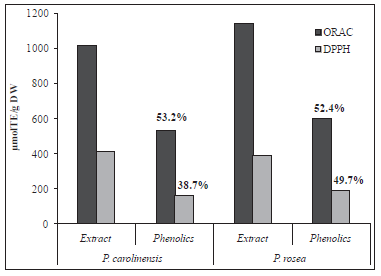Antioxidant fractions and phenolic constituents from leaves of Pluchea carolinensis and Pluchea rosea
DOI:
https://doi.org/10.5530/fra.2014.2.1Keywords:
Antioxidant potential, Caffeoylquinic acid derivatives, Cinnamic acids, Flavonoids, Phenolic profileAbstract
Objective: The objective is to evaluate the antioxidant potential of several polar fractions of Pluchea carolinensis and Pluchea rosea as well as pure chemicals, some of them quantified in both species by high-performance liquid chromatography (HPLC). Methods: The antioxidant potential of polar fractions and pure chemicals were assayed by 2,2-diphenyl-1-picrylhydrazyl (DPPH) and oxygen radical potential methods. The phenolic content was performed by using Folin-Ciocalteu’s reagent. Specific phenolic acids and flavonoids were quantified by diode array detector-reversed phase-HPLC. Results: The highest DPPH antioxidant potential expressed in milligrams of trolox equivalents per gram of dry extract (mg TE/gDE) were frequently measured in fractions from n-butyl alcohol, i.e., 2 (192.1 ± 0.3); 6 (181.0 ± 0.1) of P. carolinensis and in fraction 7 (188.1 ± 5.5) of P. rosea while for oxygen radical scavenging capacity (mg TE/gDE) assay fraction 2 (543.0 ± 64.6) and 4 (501.4 ± 49.7) of P. carolinensis and 3 (401.3 ± 16.1) and 6 (401.3 ± 16.1) of P. rosea showed the best results. Some flavonoids and phenolic acids were also assayed; all of them showed highest oxygen radical absorbance capacity values. Conclusion: We report the antioxidant potential of polar fractions, as well as of some pure phenolics responsible of the antioxidant potential. Some phenolics were identified and quantified for the first time in both species. Apparently, caffeoylquinic acid derivatives contribute more significant to the total antioxidant potential of the extracts.
Downloads
Metrics





